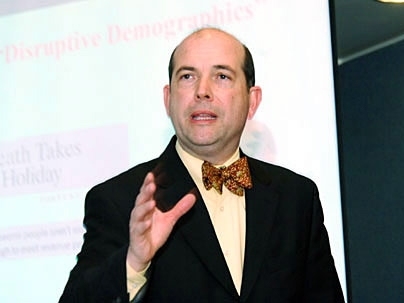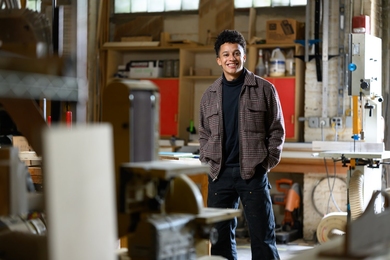The houses of the future will monitor our bodily functions through sensors in the bedrooms, bathrooms and kitchens and relay that data to drugstores that will not only fill prescriptions and sell toothpaste but also connect us with health professionals.
The demographics of aging are bringing about massive changes in society, says Joseph F. Coughlin, founder and director of the MIT AgeLab. He spoke at a Program in Science, Technology and Society (STS) colloquium, "A New Look at Old Age: Science, Technology and Choosing How We Will Live Tomorrow," on Feb. 26.
By the time we're 50, we're not likely to move. Our houses will enable us to live independently for longer by providing a variety of technologies designed to keep us healthy and provide help if necessary. Modular houses, already fitted with grab bars in the shower and wheelchair ramps, could be dropped into the backyard to accommodate elderly relatives.
Contrary to prevailing notions, older adults are the leading adopters of new technology. Wearable and implantable devices that check blood chemistry and pressure and dispense medications, robots in nursing homes and refrigerators that monitor what we eat are among the wealth of new technologies coming down the pike for the aging population.
While some changes seem like no-brainers--for instance, expanding originally assistive technologies like garage door openers and ergonomic kitchen implements to mainstream users--others raise disturbing questions about privacy, dignity and personal responsibility.
Soon, 80 percent of older adults will be living by themselves. Would you prefer to live independently even if it meant having a smart toilet gather data on your body weight, glucose and fiber content and upload it to your doctor?
Should insurance companies have the right to dictate how we live if they believe that certain health choices will save money on medical care in the long run?
Affordability is also a concern. How do we ensure technological benefits are equitably distributed across the social spectrum?
Life expectancy in the United States has increased from around 50 to around 80 in the past century. In 20 years, one in four people in the United States will be over age 60. Those numbers are higher in countries such as Germany, Italy, Japan and even China, where birth rates are declining. Those countries are wondering who is going to make up their future labor force.
The paradox of aging is, now that we're living longer, what are we going to do with all that extra time?
Although most of us will still end up with chronic diseases, we will contract them later in life, and chances are they will not incapacitate us until even later.
Coughlin points out that we live in a society that says you're done at age 65. Retirement, he pointed out, may just go away. Society can ask more of people who are capable of doing more and working longer.
People want to maintain their health and also stay connected to friends and family and continue to play a vital role in society. They want to do things, and 30 years of playing golf is not appealing to most.
"We're looking at a (Baby Boomer) generation that has greater expectations that their lives are better and different," Coughlin said. And boomers whine more, he said, and are more likely to demand more aggressive treatments.
With a multidisciplinary team, the AgeLab is looking at how to address public policy, political issues, social issues and technology for a population that may soon be routinely living to be over 100.
"All these technologies make it possible to rethink the social contract," he said. "Right now as a society, we are not geared to meet the needs and demands of an aging society."
A version of this article appeared in MIT Tech Talk on March 7, 2007 (download PDF).






